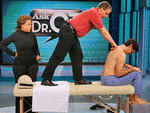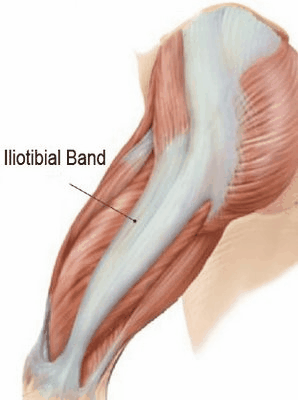
The Iliotibial BandWhat is the Iliotibial Band (IT Band)?
The iliotibial band (IT Band) is a tough group of fibers that run along the outside of the thigh. The gluteus muscles attach to its top, and the lower part attaches to the tibia, just below the knee. Iliotibial band syndrome (ITBS) occurs when there is irritation to this band of fibrous tissue. The irritation usually occurs over the outside of the knee joint, at the end of the femur (thigh) bone. The iliotibial band (IT Band) crosses bone and muscle at this point; between these structures is a bursa which should facilitate a smooth gliding motion. However, when inflamed, the iliotibial band (IT Band) does not glide easily, and pain associated with movement is the result.
Who suffers from Iliotibial Band (IT Band) Syndrome?
This condition is, most common in long-distance runners and cyclists. ITBS may also be observed in athletes who participate in volleyball, tennis, soccer, skiing, weight lifting, and aerobics. The Iliotibial band (IT Band) functions primarily as a stabilizer during running and can become irritated from overuse. Runners will usually describe pain on the outside part of the knee or lower thigh, often worsened by going up or down stairs, or getting out of a car.
The Rolfing Approach to The Iliotibial Band (IT Band)
Rolfing sees the body and its structure as a series of interconnected and inter-related bony segments. Your body is designed to provide internal support for all these segments. Large sections rest on sections below them and provide support for sections that are above them. Your Iliotibial Band (IT Band) is connected to the gluteus, the quadriceps and the hamstrings, and hence must be treated together. IT Band syndrome may also affect the knees, as it may pull on the kneecap and affect the extent to which your kneecap can comfortably rotate. Your Rolfer will assess your body as a whole, and treat it as a whole, making sure you are holistically able to return your activity after your Rolfing sessions.
How does Rolfing treat Iliotibial Band (IT Band) Syndrome?
Rolfing treats the Iliotibial Band, and IT Band Syndrome using myofascial release. Myofascial release is a form of soft tissue therapy in Rolfing that works on the fascial system to provide pain relief, increase your range of motion and balance your body for optimum posture. The Rolfer will use his knuckles and elbow to work the Iliotibal Band (IT Band) and dissolve the tension. This releases the strain on the Iliotibial Band (IT Band).
What are the advantages of Rolfing for the Iliotibial Band (IT Band)?
The tension in the Iliotibial Band (IT band) is not easily released through normal stretching because you cannot stretch the Iliotibial Band (IT band) on your own the way you can stretch the hamstrings, the quadriceps or most other major muscles. Thus the tension in the IT Band has to be released through a hands-on or tactile approach as it cannot be easily dissolved through stretches and exercise. A hands-on rolfing therapist is best placed to release it. Rolfing’s great strength is that it is non-invasive, and hence while undergoing Rolfing you will be able to continue with daily life and even sports, while simultaneously treating and relaxing your neck muscles, which will eventually allow you a greater range of movement of the neck and increase your flexibility.
Iliotibial Band
|

Certified Rolfer®
Vincent Lee
Rolfing was featured in


“Two Hands” 2007 Academy Award. Nominated for documentary film.

Andrew Weil, M.D.
“Good Morning From Dr. Weil.com” An on-line daily newsletter published a health news brief June 25, 2004--“Tip: Is Your Posture Bad? Today’s Tip-Rolfing."
